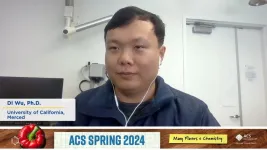(Press-News.org) NEW ORLEANS, March 20, 2024 — From abstract-looking cloud formations to roars of snow machines on ski slopes, the transformation of liquid water into solid ice touches many facets of life. Water’s freezing point is generally accepted to be 32 degrees Fahrenheit. But that is due to ice nucleation — impurities in everyday water raise its freezing point to this temperature. Now, researchers unveil a theoretical model that shows how specific structural details on surfaces can influence water’s freezing point.
The researchers will present their results at the spring meeting of the American Chemical Society (ACS). ACS Spring 2024 is a hybrid meeting being held virtually and in person March 17-21; it features nearly 12,000 presentations on a range of science topics.
“Ice nucleation is one of the most common phenomena in the atmosphere,” says Valeria Molinero, a professor of physical and materials chemistry. “In the 1950s and 1960s, there was a surge of interest in ice nucleation to control weather through cloud seeding and for other military goals. Some studies addressed how small shapes promote ice nucleation, but the theory was undeveloped, and no one has done anything quantitative."
When temperatures drop, the molecules in liquid water, which normally speed around and zip past one another, lose energy and slow down. Once they lose enough energy, they grind to a halt, orient themselves to avoid repulsions and maximize attractions, and vibrate in place, forming the crystalline network of water molecules we call ice. When liquid water is completely pure, ice may not form until the temperature gets down to a frigid –51 degrees Fahrenheit; this is called supercooling. But when even the tiniest impurities — soot, bacteria or even particular proteins — are present in water, ice crystals can form more easily on the surfaces, resulting in ice formation at temperatures warmer than –51 degrees Fahrenheit.
Decades of research have revealed trends in how the shapes and structures of different surfaces affect water’s freezing point. In an earlier study on ice-nucleating proteins within bacteria, Molinero and her team found that the distances between the groups of proteins could impact the temperature at which ice formed. “There were distances that were very favorable for ice formation, and distances that were completely opposite,” says Molinero.
Similar trends had been observed for other surfaces, but no mathematical explanation had been found. “People before already had a sense of ‘oh maybe a surface will inhibit or promote ice nucleation,’ but no way to explain or predict what they observed experimentally,” says Yuqing Qiu, a postdoc, who is presenting the work at the meeting. Both Qiu and Molinero carried out this research at the University of Utah, though Qiu now works at the University of Chicago.
To address this gap, Molinero, Qiu and team gathered hundreds of previously reported measurements on how the angles between microscopic bumps on a surface affected water’s freezing temperature. They then tested theoretical models against the data. They used the models to consider factors that would encourage ice crystal formation, such as how strongly water binds to the surfaces and angles between structural features.
In the end, they identified a mathematical expression that shows that certain angles between surface features makes it easier for water molecules to gather and crystallize at relatively warmer temperatures. They say their model can help design materials with surfaces that would make ice form more efficiently with minimal energy input. Examples include snow or ice makers, or surfaces that are suitable for cloud seeding, which is used by several Western states to increase rainfall. It could also help better explain how tiny mineral particles in the atmosphere help make clouds through ice nucleation, potentially making weather models more effective.
The researchers plan to use this model to return to their studies of ice-nucleating proteins in bacteria. More than 200 proteins are believed to be ice-nucleating proteins, but their structures are not all known. The researchers hope to study proteins with structures that have been solved with AI tools, and then they will model how aggregates of those proteins affect ice formation.
The research was funded by the National Science Foundation, the Air Force Office of Scientific Research and the Yen Fellowship from the Institute for Biophysics Dynamics at the University of Chicago.
Visit the ACS Spring 2024 program to learn more about this presentation, “The most potent snow makers,” and more scientific presentations.
###
The American Chemical Society (ACS) is a nonprofit organization chartered by the U.S. Congress. ACS’ mission is to advance the broader chemistry enterprise and its practitioners for the benefit of Earth and all its people. The Society is a global leader in promoting excellence in science education and providing access to chemistry-related information and research through its multiple research solutions, peer-reviewed journals, scientific conferences, eBooks and weekly news periodical Chemical & Engineering News. ACS journals are among the most cited, most trusted and most read within the scientific literature; however, ACS itself does not conduct chemical research. As a leader in scientific information solutions, its CAS division partners with global innovators to accelerate breakthroughs by curating, connecting and analyzing the world’s scientific knowledge. ACS’ main offices are in Washington, D.C., and Columbus, Ohio.
To automatically receive news releases from the American Chemical Society, contact newsroom@acs.org.
Note to journalists: Please report that this research was presented at a meeting of the American Chemical Society. ACS does not conduct research, but publishes and publicizes peer-reviewed scientific studies.
Follow us: X, formerly Twitter | Facebook | LinkedIn | Instagram
Title
The most potent snow makers
Abstract
Several organisms have evolved proteins that control the formation of ice. Ice nucleating bacteria are the most potent ice-nucleating agents in the biosphere and the atmosphere, contributing to cloud glaciation and precipitation, and routinely used for the synthetic production of snow. These bacteria have proteins in their outer membrane that are able to nucleate ice at temperatures as high as –1 °C. This presentation will discuss our quest to elucidate the mechanisms by which bacterial proteins and other potent ice nucleants promote water crystallization, what makes them so outstanding, and whether we can design materials that outperform them.
END
NEW ORLEANS, March 20, 2024 — Accidents happen every day, and if you drop your smartwatch, or it gets hit really hard, the device probably won’t work anymore. But now, researchers report on a soft, flexible material with “adaptive durability,” meaning it gets stronger when hit or stretched. The material also conducts electricity, making it ideal for the next generation of wearables or personalized medical sensors.
The researchers will present their results today at the spring meeting of the American Chemical Society (ACS). ACS Spring ...
SARS-CoV-2, the virus that causes COVID-19, can damage the heart even without directly infecting the heart tissue, a National Institutes of Health-supported study has found. The research, published in the journal Circulation, specifically looked at damage to the hearts of people with SARS-CoV2-associated acute respiratory distress syndrome (ARDS), a serious lung condition that can be fatal. But researchers said the findings could have relevance to organs beyond the heart and also to viruses other than SARS-CoV-2.
Scientists have long known that COVID-19 increases the risk of heart attack, stroke, and Long COVID, ...
In an analysis of information on Medicare beneficiaries with dementia, Medicare expenditures were higher for Black and Hispanic individuals compared with whites. The Journal of the American Geriatrics Society analysis also found that expenditures were highest for Black beneficiaries in every phase of care.
The average total Medicare expenditures after being diagnosed with dementia were $165,730 for Black beneficiaries, $160,442 for Hispanic beneficiaries, and $136,326 for white beneficiaries. In the year preceding and immediately following ...
Previous research has identified genetic variants linked to sedentary leisure behavior, which includes activities such as watching television, using a computer, and operating a vehicle. In a new analysis published in Andrology, a higher genetic susceptibility to leisure computer usage was associated with a greater risk of erectile dysfunction in men.
In the analysis of data on more than 200,000 men, each 1.2 hour increase in leisure computer usage predicted 3.57-fold greater odds of erectile dysfunction. There was no evidence to suggest ...
New research indicates that antibiotics can effectively target bacteria in the gut that harbor the virus that causes COVID-19 and produce toxin-like peptides that contribute to COVID-19-related symptoms. In the study, which involved 211 participants and was published in the Journal of Medical Virology, individuals who received early antibiotic treatment after having COVID-19 recovered more quickly than those who did not receive antibiotics.
The authors had already evaluated the efficacy of certain antibiotics in SARS-CoV-2-infected bacterial cultures in vitro, and this new study demonstrates ...
Consumer sentiment generally refers to consumers’ attitudes and expectations about economic conditions. A new analysis published in Economic Inquiry indicates that U.S. party affiliation has a significant effect on consumer sentiment, and that sentiment, in turn, affects spending intentions.
In the study that relied on information dating back to 1991 and focused on data surrounding elections in which the governing party changed, survey respondents from Florida whose party affiliation matched the winning U.S. presidential candidate reported more optimistic views about personal and national economic conditions immediately after the election. In ...
Executive functions (EFs) have been defined as the ability to regulate emotions, thoughts, and behaviors to achieve a goal. Although EFs have been identified as a cornerstone of cognitive development, knowledge of this fundamental ability in children is primarily based on research with North American and Western European samples from middle to high socioeconomic status.
A new article published in the journal Child Development Perspectives highlights the advances that have been made in developmental EFs research from Latin American
(LATAM) regions, an understudied area that provides a unique context important to understanding EFs. The ...
IVI will complete the technology transfer by 2025
Oral Cholera Vaccine to be manufactured by Biological E. Limited for India and international markets
March 20, 2024, SEOUL, Republic of Korea and HYDERABAD, India — The International Vaccine Institute (IVI), an international organization with a mission to discover, develop, and deliver safe, effective, and affordable vaccines for global health, today announced that it has commenced a technology transfer of simplified Oral Cholera Vaccine (OCV-S) to Biological ...
A new paper in Rheumatology, published by Oxford University Press, finds that rheumatic diseases can lead to reproductive problems, though some conditions have more detrimental effects than others.
Immune-mediated diseases are a varied group of conditions, but each display an aberrant activity of the immune system. Some diseases, such as juvenile idiopathic arthritis and type 1 diabetes, occur mostly before patients reach their reproductive years, but others show up later in life. Scientists have investigated systemic lupus erythematosus for its impact on reproductive health; the condition increases the risk for some adverse pregnancy ...
Words are important to express ourselves. What we don’t say, however, may be even more instrumental in conveying emotions. Humans can often tell how people around them feel through non-verbal cues embedded in our voice.
Now, researchers in Germany wanted to find out if technical tools, too, can accurately predict emotional undertones in fragments of voice recordings. To do so, they compared three ML models’ accuracy to recognize diverse emotions in audio excepts. Their results were published in Frontiers in Psychology.
“Here we show that machine learning can be used ...




